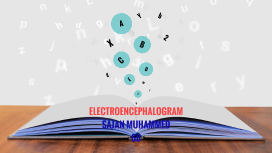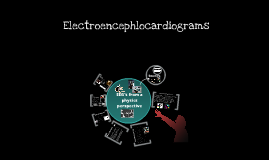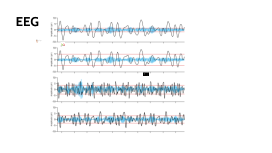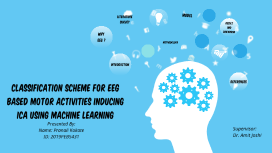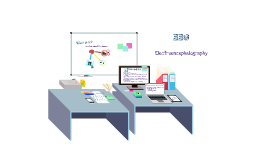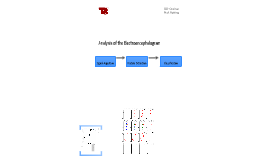EEG
Transcript: Classification SCHEME for EEG based Motor Activities inducing ICA using Machine Learning Presented By: Name: Pranali Kokate ID: 2019PEB5431 Supervisor: Dr. Amit Joshi Introduction Neurologists are increasingly developing methods and means to integrate brains and machines. The most significant of them are brain-computer interfaces (BCIs), which can provide alternative modes of communication and enables control of external equipment even in severe situations of impairment. In this field, research is developing in all aspects, be it the large scope of EEG-based BCI[2] controls, the technological depth involved, and its usability for impaired people and the rest of the population. Every day, new and creative scientific advancements are being investigated in order to improve the lives of millions of people all over the world. Many researchers have developed EEG-based BCI systems to overcome the problem. An Electroencephalogram[1] is created by collecting and storing electrical signals taken from the brain. Thus providing an ability to extract relevant information about brain activities. Introduction [1]Guangyi Zhang, Ali Etemad, A.S.Moghaddam, Y Zhang, "Classification of Hand Movements from EEG Using a Deep Attention based LSTM Network." IEEE Senors Journal ,March 15 2020. [2] S. N. Abdulkader, A. Atia, and M.-S. M. Mostafa, “Brain computer interfacing: Applications and challenges,” Egyptian Inform. J., vol. 16,pp. 213–230, Jul. 2015 Techniques in bcI Why EEg ? There are different techniques in BCI Invasive as well as Non-invasive [3] Magnetoencephalography (MEG) : MEG is a noninvasive neurological recording technique that captures the magnetic activities produced by natural sources like the electrical impulses of neurons in the brain. Functional Magnetic Resonance Imaging: fMRI is yet another non-invasive technique of brain scanning method that uses electromagnetic fields to detect and record. Functional Near-Infrared Spectroscopy (fNIRS): The fNIRS is a noninvasive brain wave collection method that uses near-infrared light to quantify alterations in localised cerebral metabolism while performing particular neural activity. EEG based BCI standsout from its conterparts due its long-lasting usability, high temporal resolution, ease of installation, and low prices. Sanei, S 2013, Adaptive Processing of Brain Signals, John Wiley & Sons, Incorporated, Hoboken. Available from: ProQuest Ebook Central. State-of-art technique adopted with different EEG parameters literature Survey We reviewed various available data sets related to motor imagery and execution activities. Several features associated with EEG signals. Different Pre-processing technique. Various classification algorithms from machine learning to deep learning. Research gap Research gap Proper selection of channels[1]. Despite applying the digital filter to EEG, contaminated data still exists, because such data is generated by eye blinks and head movements. To obtain cleaned EEG data, we removed the contamination factors by an independent component analysis (ICA) which is commonly used to decompose the brain signals into statistically independent components (ICs). [3] The fundamental disadvantage of EEG signals is that they are vulnerable to both external and other biological influences. There must be a thorough discussion as well as some conventional ways for removing the tainted noises. Validation of the applied procedures is required. [3] Brain-Controlled Robotic Arm System Based on Multi-Directional CNN-BiLSTM Network Using EEG Signals, Ji-Hoon Jeong , Kyung-Hwan Shim , Dong-Joo Kim , and Seong-Whan Lee , 5, May 2020 Objective 1.The identification and extraction of relevant signals from the raw EEG data is likely the primary goal for that we considered a publicly available dataset. 2. Understanding the structure of the brain for effective electrode selection. 3. To implement an algorithm for removing artifacts and cleaning signals. 4. To propose a classification Machine Learning model using ANN. 5. To develop a deep learning-based framework for an EEG-based BCI system. Methodology Methodology data-set BCI Dataset for motor imagery and motor execution The EEG Movement Dataset was used in this study. The dataset includes 109 subjects and has been collected using a BCI 2000 system. [7] Participants were asked to perform three actions: rest (T0), left hand movement (T1), and right hand movement (T2). Each experiment consisted of 15 iterations, where T0 was followed by a visual stimulus, randomly selecting either T1 or T2. This 15-pair movement process was repeated 3 times. The data set consists of 109 subjects and each subject is performing 14 tasks among 14 tasks we considered only 6 tasks. Here 3,7 and 11 runs represent motor execution class while 4,8 and 12 runs represent motor imagery class. The dataset contains 64-channels of EEG, recorded at a sampling frequency of 160 Hz. Figure illustrates a sample EEG recording and the three actions T0,T1, and T2. [7]







